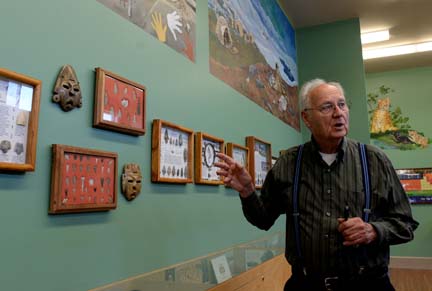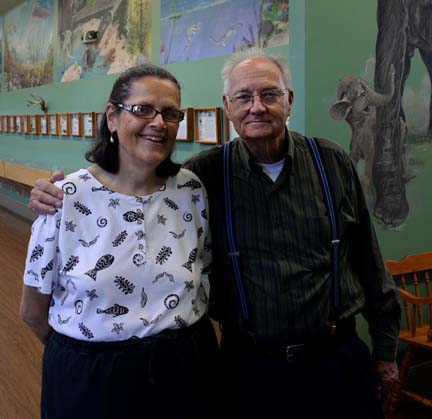One tiny town scored this ‘gem’ of a natural history museum
By Meg Haskell
BDN Staff
Like many rural communities in Maine, the Piscataquis County town of Milo, with a population of about 2,400, is struggling a bit these days. Its 19th and 20th century heydays as a prosperous mill town and railroad center are a memory, lost to changing trends in manufacturing, energy and transportation. A 2008 fire leveled many of the historic buildings and shut down businesses on Main Street. Few new enterprises have braved the region’s shaky economic times.
 Photo by Linda Coan O’Kresik/BDN
Photo by Linda Coan O’Kresik/BDN
MUSEUM — Tom Harrigan, 84, and his wife, Nancy, 72, have opened a new museum of paleontology, geology and archaeology, called the Harrigan Learning Center and Museum in Milo that is filled with thousands of specimens collected from his travels around the world.

But while its future is uncertain, Milo boasts a new portal to the distant, global past. Retired telecommunications engineer Tom Harrigan, 84, and his wife, Nancy, 72, longtime summer residents in the area who in 2009 settled in Milo, have opened a new museum of paleontology, geology and archeology, filling it with thousands of specimens collected during a lifetime of travel throughout the world.
The project, developed in partnership with and now under the ownership of the Three Rivers Milo-Brownville Kiwanis Foundation, has tapped the talents of local craftsmen, artists and others.
“This is my collection from my home,” Tom Harrigan said during a recent tour of the museum. “It was all under the beds, in drawers, in the closets. People ask me, ‘How could you have had all that stuff in your house?’ But I did.”
A gem of a museum
Step through the doors of the 2,400-square-foot Harrigan Learning Center and Museum at the northern edge of town and be transported back to the Cambrian age, the very start of the fossil record on Earth. Specimens in this large, surprising collection range from fossilized 550-million-year-old trilobites to a 20th century, hand-carved shield from the jungles of New Guinea. A mind-blowing array of fossilized dinosaur bones, shark teeth, mastodon teeth, walrus tusks, turtle shells, deer antlers, plant specimens and much, much more are chronologically arranged in glass-topped wooden cases, accompanied by maps, graphs and carefully typed informational labels explaining where each was collected and the time period it represents.
Around the corner in an adjoining space, the collection changes from fossil to mineral specimens. These include football-sized geodes, broken open to display their sparkling, jeweled interiors, and feathery dendrites from Mexico, formed by the calcification of manganese oxide into delicate branching patterns etched in rock. In a separate room, a large collection of fluorescing stones glow in intense shades of aqua, hot pink and orange when exposed to ultraviolet light.
Gradually, the human record emerges, with cast resin models of the skulls of human ancestors, Indian artifacts and tools such as arrowheads and stone axes. Some aboriginal items were collected in the Milo area, along with specimens from cultures throughout the Americas and across the globe.
Harrigan purchased some of the specimens but collected many himself. The breadth of the collection and the care with which it is displayed is remarkable.
“This is a great gem of a museum, well put together and totally correct,” said Harold Borns, a retired professor of geology and founding director of the Climate Change Institute at the University of Maine. Borns met Harrigan three years ago and has supported the museum project ever since. While the collection doesn’t contain any unique specimens or surprises, he said, it represents a remarkable opportunity for Mainers to view a global collection not equalled anywhere else in the state.
“It is unique to central Maine and in no way distorts Earth’s history at all,” he said.
“It is very nicely done,” said Gretchen Faulkner, director of the Hudson Museum at UMaine and board member of Maine Archives and Museums, who visited the Harriman museum last week. “It is quite a comprehensive collection, and [Harrigan] interprets it very well for visitors.”
‘All his idea’
Born in New York City, Harrigan began collecting fossils and minerals in his teens. While he built a successful career with Bell Laboratories in New Jersey, he nurtured his passion for collecting throughout his adult life, especially on vacations and after retirement.
“A lot of this collecting was done as part of our travels,” he said, looking at Nancy, his wife of more than 40 years.
“It was all his idea,” Nancy said. “I just went along as the driver.”
In Central and South America, across Europe and Asia, in Australia and New Zealand and in every state in the U.S., the couple visited established fossil-hunting grounds and mineral mines, as well as following Tom Harrigan’s instincts for searching off the beaten path. Many of his best specimens, including a baby mammoth tusk, were discovered in rivers in central Florida, where the Harrigans lived for more than 10 years before coming to Maine.
Once they got settled in Milo, Tom Harrigan said, he started thinking about how best to hand his prized collection on for the future.
“I want to keep it in Milo,” he said. “I want it to benefit the schoolchildren and the economy of the town.” Initial proposals to give the collection to the town or the schools were rejected. “Maybe they just didn’t want the responsibility,” Harrigan said. “So then I decided that the only way I was going to get a museum was to build it myself.” And he did.
Community pride
To realize his goal, Harrigan worked with the local Kiwanis club, of which he is a member.
On a piece of land purchased from the town for $1, he paid about $250,000 out of his own pocket for the construction of a new Kiwanis facility, including a large kitchen, meeting space and an auction area.
It’s the first time the civic club has had a home of its own, club president Brenda Kelly said. “Before this, we just met at the town hall.”
The club raises money for reading programs and swimming lessons for local children, a Secret Santa holiday event for struggling families and other community projects. In addition to supporting the annual auction and other fundraising activities, the new facility has been in demand for weddings and other private events. “We’ve been booked solid every weekend this summer,” Kelly said.
Once the new club facility was built, Harrigan turned his attentions to building the museum on the same parcel, using local builders and contractors. The construction cost about $200,000.
Area resident Linda Belisle, 73, caught wind of the project and volunteered her time and energy to help set up the birch display cases.
“I knew absolutely nothing about how to do it,” she said, but she soon found herself in charge of lining the cabinets with fabric and arranging the specimens. She learned a lot along the way. “I had never even heard of a geode,” she said. “It blows my mind that that it just looks like a plain rock until you slice it open.”
The museum also features large, colorful, action-filled murals by Brownville artist Suzette East. Her panels depict specific periods and milestones in the history of the planet, from the late Cambrian oceans teaming with simple organisms to a dour prospector panning for gold with Mount Katahdin rising in the background.
Harrigan has donated his entire collection to the Kiwanis foundation, entrusting it to the organization’s care for the future. He’s at peace with this decision, knowing the vast collection amassed over his lifetime will be protected and used to benefit the community he has come to regard as home. Through educational programs and tourism, he hopes the unusual museum will develop pride in the area, create economic opportunity and expand inquisitive minds.
“When people come here, I tell them this is your museum, something you can be proud of,” he said. “When you come in here and you see these things, it just has to open your mind up.”